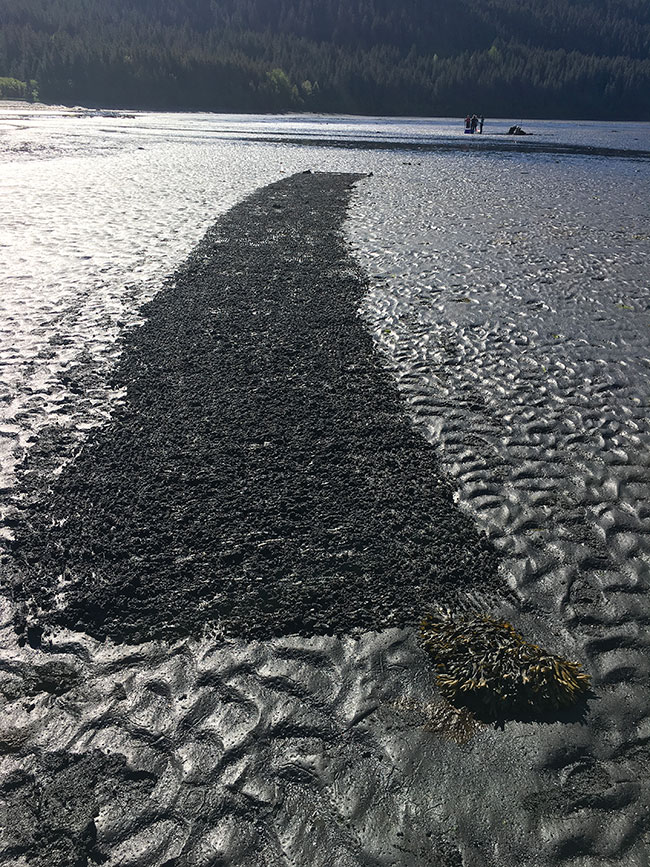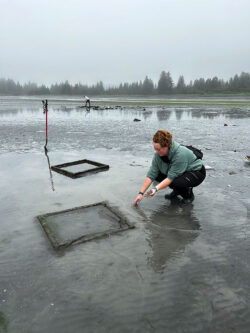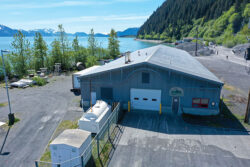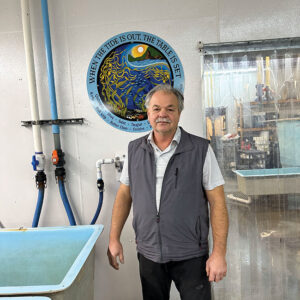
Shell pride in Alaska
March 29, 2024
By Jeff Hetrick, Alutiiq Pride Marine Institute
Alutiiq Pride Marine Institute explores soft shell clams as a new aquaculture opportunity
 Jeff Hetrick is the mariculture director of the Alutiiq Pride Marine Institute (APMI). APMI is a tribally managed marine research facility in Seward, Ala., USA. Hetrick is also a board member of the Northwest Aquaculture Alliance. www.alutiiqprideak.org
Jeff Hetrick is the mariculture director of the Alutiiq Pride Marine Institute (APMI). APMI is a tribally managed marine research facility in Seward, Ala., USA. Hetrick is also a board member of the Northwest Aquaculture Alliance. www.alutiiqprideak.org The Alutiiq Pride Marine Institute (APMI) has been working on shellfish enhancement and gardening efforts for over thirty years mostly focusing on native littleneck and butter clams in south-central Alaska. During this time, staff have noticed an increasing expansion of the populations of the soft-shell clam (Mya arenaria) both in geographical distribution and densities on beaches near the tribal communities they serve.
Shellfish have been a staple of diets in coastal communities in Alaska and has significant cultural importance, but that resource has been dwindling over the past several decades. The decline of these populations has been attributed to a long list of factors including the 1964 earthquake, overharvest, predation and changing environmental conditions. The prevalence of soft-shell clams despite being exposed to the same factors that have been attributed to the decline of hard-shell populations suggests that the soft-shell clam is better suited for the current environment or has adapted to the changing conditions.
Clam origins
 Soft shell clams are ubiquitous on the east coast of the United States. It is a high-value species in aquaculture and fisheries. On the west coast, they are known to extend from California through the Aluetian Islands in western Alaska. There is historical (paleontological) evidence of their existence in Alaska butare described as an “unintentional and intentional introduction”. Regardless of their pathway they are becoming more and more common.
Soft shell clams are ubiquitous on the east coast of the United States. It is a high-value species in aquaculture and fisheries. On the west coast, they are known to extend from California through the Aluetian Islands in western Alaska. There is historical (paleontological) evidence of their existence in Alaska butare described as an “unintentional and intentional introduction”. Regardless of their pathway they are becoming more and more common.
APMI staff saw an opportunity for a new aquatic species for commercial farming. Our first efforts with production in 2021 were exciting because we just used the basic shellfish culture cookbook, and the hatchery cycle went very well. Their larvae cycle, settling, and nursery went smoothly, and we were encouraged by how easy they were to raise.
The clams grew very quickly with a three-week larvae cycle at 16 C and reached 10 mm or more after a couple months in the nursery, much faster than the hardshell clams. Based on those encouraging results, the staff increased efforts the next year by repeating the hatchery process and began developing growout strategies. Fortunately, there is a lot of information about soft shell clams out there. It was just a matter of finding what is applicable to our situation.
About the field work
For convenience, APMI chose Resurrection Bay where the Institute is located for its initial field work.
The APMI team tried a couple of methods of outplanting to see what works best in this region. The crew looked at mesh netting for predator control, plastic tubes to easily identify groups and planting sites and light scattering of seed over the raked substrate. Even though it was not a scientific study, the staff was excited at the preliminary results and are looking forward to redoubling efforts in 2024 expanding nursery efforts and looking at additional test sites.
We’re trying to get a three-year clam or better if we can. We’re going to try to push spawning up earlier on the calendar and increase feed and temperature. If we can get large seed planted by the fall of the year we think we can get harvestable clams to two inches or more with three full growing seasons.
Economics of farming
The economics for private farming of soft-shell clams is very speculative at this point but based on reports from other regions it may provide an opportunity in Alaska. Developing efficient cost cost-effective growout techniques applicable to Alaska, keeping production costs low and producing a premium product will be critical. It will also be imperative to support farmers with assisting in obtaining tideland leases and financial support during the development phase.

Exterior view of the Alutiiq Pride Marine Institute
We also realized that they can’t produce shellfish without considering shellfish sanitation and safety. We have a robust harmful algae lab where we regularly monitor shellfish toxicity through tissue and algae population studies. We are paying special attention to see what types of trends we see with their uptake and accumulation,” stated shellfish biologist Annette Jarosz. There have been no detectable presences so far.
APMI staff sees other positive outcomes from this effort. Having these clams under culture for their complete life cycle allows us a deeper understanding of their reproductive biology, behavior and growth and survival. It affords us an opportunity to fulfill a goal of providing additional food sources for our tribal members outside of commercialization and provides ecosystem services through nutrient cycling and beach stabilization on once productive beaches.
 Jeff Hetrick is the mariculture director of the Alutiiq Pride Marine Institute (APMI). APMI is a tribally managed marine research facility in Seward, Ala., USA. Hetrick is also a board member of the Northwest Aquaculture Alliance. www.alutiiqprideak.org
Jeff Hetrick is the mariculture director of the Alutiiq Pride Marine Institute (APMI). APMI is a tribally managed marine research facility in Seward, Ala., USA. Hetrick is also a board member of the Northwest Aquaculture Alliance. www.alutiiqprideak.org
Advertisement
- Stanford research examines relationship between small-scale fisheries and aquaculture
- AquaBounty reports increased losses in Q4 2023





